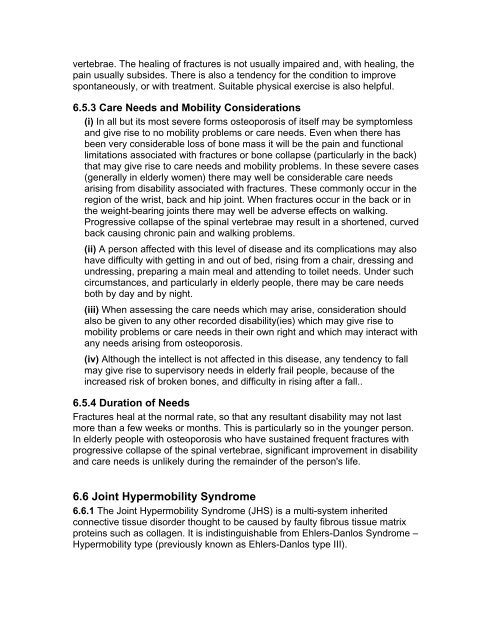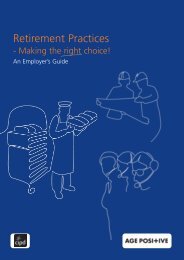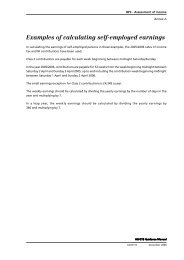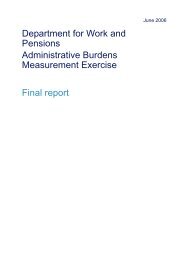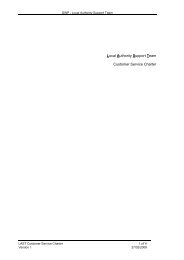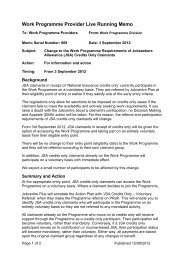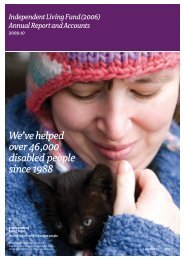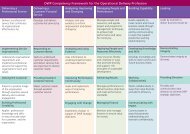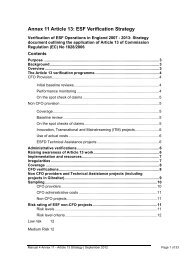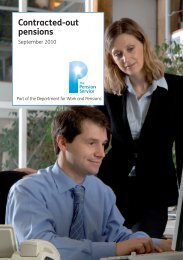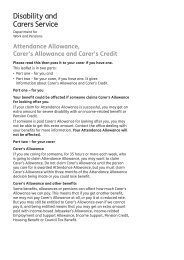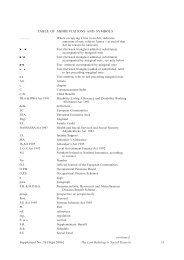Arthritis, rheumatism, musculo-skeletal and rheumatological disorders
Arthritis, rheumatism, musculo-skeletal and rheumatological disorders
Arthritis, rheumatism, musculo-skeletal and rheumatological disorders
Create successful ePaper yourself
Turn your PDF publications into a flip-book with our unique Google optimized e-Paper software.
vertebrae. The healing of fractures is not usually impaired <strong>and</strong>, with healing, the<br />
pain usually subsides. There is also a tendency for the condition to improve<br />
spontaneously, or with treatment. Suitable physical exercise is also helpful.<br />
6.5.3 Care Needs <strong>and</strong> Mobility Considerations<br />
(i) In all but its most severe forms osteoporosis of itself may be symptomless<br />
<strong>and</strong> give rise to no mobility problems or care needs. Even when there has<br />
been very considerable loss of bone mass it will be the pain <strong>and</strong> functional<br />
limitations associated with fractures or bone collapse (particularly in the back)<br />
that may give rise to care needs <strong>and</strong> mobility problems. In these severe cases<br />
(generally in elderly women) there may well be considerable care needs<br />
arising from disability associated with fractures. These commonly occur in the<br />
region of the wrist, back <strong>and</strong> hip joint. When fractures occur in the back or in<br />
the weight-bearing joints there may well be adverse effects on walking.<br />
Progressive collapse of the spinal vertebrae may result in a shortened, curved<br />
back causing chronic pain <strong>and</strong> walking problems.<br />
(ii) A person affected with this level of disease <strong>and</strong> its complications may also<br />
have difficulty with getting in <strong>and</strong> out of bed, rising from a chair, dressing <strong>and</strong><br />
undressing, preparing a main meal <strong>and</strong> attending to toilet needs. Under such<br />
circumstances, <strong>and</strong> particularly in elderly people, there may be care needs<br />
both by day <strong>and</strong> by night.<br />
(iii) When assessing the care needs which may arise, consideration should<br />
also be given to any other recorded disability(ies) which may give rise to<br />
mobility problems or care needs in their own right <strong>and</strong> which may interact with<br />
any needs arising from osteoporosis.<br />
(iv) Although the intellect is not affected in this disease, any tendency to fall<br />
may give rise to supervisory needs in elderly frail people, because of the<br />
increased risk of broken bones, <strong>and</strong> difficulty in rising after a fall..<br />
6.5.4 Duration of Needs<br />
Fractures heal at the normal rate, so that any resultant disability may not last<br />
more than a few weeks or months. This is particularly so in the younger person.<br />
In elderly people with osteoporosis who have sustained frequent fractures with<br />
progressive collapse of the spinal vertebrae, significant improvement in disability<br />
<strong>and</strong> care needs is unlikely during the remainder of the person's life.<br />
6.6 Joint Hypermobility Syndrome<br />
6.6.1 The Joint Hypermobility Syndrome (JHS) is a multi-system inherited<br />
connective tissue disorder thought to be caused by faulty fibrous tissue matrix<br />
proteins such as collagen. It is indistinguishable from Ehlers-Danlos Syndrome –<br />
Hypermobility type (previously known as Ehlers-Danlos type III).


